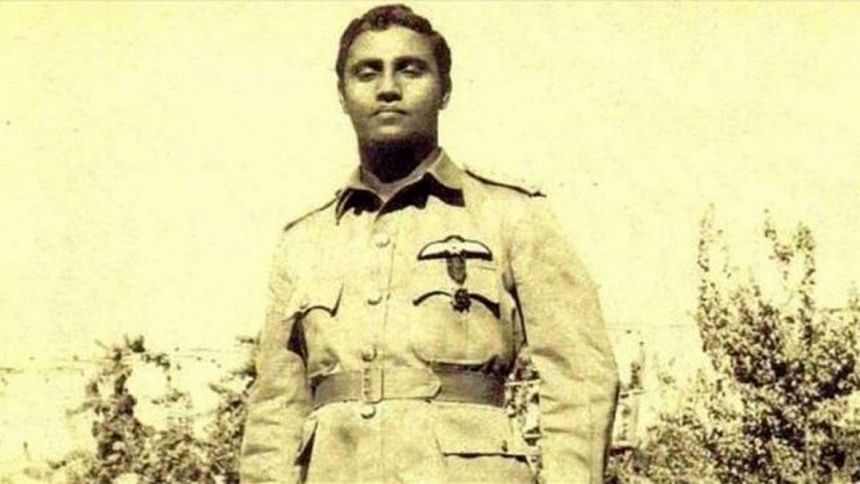The “Living Eagle” who beat the heavy odds!

He departed rather unsung, his glorious past recalled in this country by only a few of his friends and admirers, limited to Facebook posts mainly. The BAF burial ceremony was a very fitting farewell, by his brothers-in-arms who don the sky blue, to an ace pilot to whom so much will be owed by so many peoples and so many countries for a long time. None though, perhaps, who had shared the sky with him could be present. There are possibly only a very few amongst us living who had the good fortune to share the company of this very unassuming personality, when he was in harness. Behind that simple and modest facade hid a personality whose company many kings and coronets, princes and prime ministers, generals and air marshals, had felt proud to have.
Group Captain Saiful Azam lived fully up to his name, which means the Great Sword, both in letter and spirit. Azam demonstrated the mettle in him as a potentially great fighter pilot from the very seminal stages of his career which started with his commission in 1960 in the PAF. He attended the Advanced Fighter Course in the US and earned the most coveted "Top Gun Trophy," an award earned only by the best among the best of the trainee officers for excellence in flying skills. He is the only pilot to have participated in combat for three different air forces, and the only pilot to have shot down three Israeli aircraft. When the Arab Israeli war of 1967 broke out, Azam was an advisor to the Royal Jordanian Air Force. And when the Israelis attacked the vital Mafruk airbase in Jordan they were surprised by the lone Hunter fighter opposing them—flown by Azam. In the aerial combat that ensued, he shot down one Mystère and damaged another. He did the same for the Iraqi Air Force taking the toll of two more Israeli aircraft. The only pilot to have earned high gallantry awards from three countries, Azam's international repute as a fighter pilot also earned him the unique distinction of being included in the International Hall of Fame by the US Government as a "Living Eagle" in 2001, thereby joining the illustrious company of a handful of legendry pilots.
The dawn and the prime of his life were scripted by Providence. His prime was as if the gods were vying with one another to shower him with approbation and accolades and adorn him with the crown of glory for his successes and triumphs. But it is a feeling of remorse that one is overcome with to think that the departure of a brave heart—of a legend—who has gone finally to meet the Almighty whose nearness he must have felt often up in the vast blue expanse when he was chasing Indian fighters in the 1965 Indo-Pak War or Israeli Mystères in the Arab-Israeli War of 1967, has gone almost unnoticed by the media in Bangladesh.
But those who owe a deep debt of gratitude, both at individual and national levels, did not forget Group Captain Saiful Azam on his passing away. And that is not one or two but four different countries. Iraq and Jordan are grateful for his valour in the air which salvaged a modicum of credibility for those two countries. Palestinians did not forget him either on his passing away; renowned Palestinian journalist Tamer al-Mishal extolled Azam, as "the Eagle of the Air". In the 1965 Indo-Pak War, his interdictions and ground attack missions, twelve in 10 days, wreaked havoc on the advancing adversary in the Kasur and Sialkot sectors.
Not only his friends but also his foes recalled his heroics. In Israel, Azam is recognised for his bravados, recalled anew when his death was reported prominently in major Israeli newspapers. But in Bangladesh he got mentioned in just a few lines in the inside pages of a few newspapers only.
In the air battles he was like the chivalrous soldiers of yesteryears. It is said that Saladin in one of his battles against Richard the Lionheart displayed his lion heartedness when, learning that Richard had lost his mount had a fresh one sent to him, because he didn't want to fight a battle against an army with a disadvantaged commander. So did Azam, in the 1967 Arab-Israeli War. On one occasion, in spite of having an Israeli aircraft in his gun sight from the enemy's rear, he rolled over and approached the enemy from his side, shooting at his tail instead at his fuselage. The Israeli pilot parachuted safely to earth—to recount the incident.
What the Israeli pilot says also is that as he was descending, Azam made a roll and loop and waved at him before pulling away to shoot down another Israeli aircraft. If Azam had wanted, the Israeli would not have been alive to tell the story to his son, who narrated it to a Bangladeshi officer, in the presence of many other officers who happened to be attending a course in Switzerland in 1979 with him. All Azam had to do was to shoot at the fuselage instead of the tail. And that would have been the end of the Israeli. This reveals the chivalrous as well the humane element in the man. War is not about blood and guts only. He destroyed the Israeli Mystère but afforded a second chance at life to the enemy pilot, acknowledged as such later by the pilot himself. Can there be a greater blend of the humane and the chivalrous in a person? That was Saiful Azam the man. He was a brave man as well as a brave soldier, he rejoiced in adversity just as he triumphed in war, fitting perfectly the definition of both a brave man and a brave soldier as characterised by Seneca 2,000 years ago.
In 1971 April, while in Karachi Masroor Airbase, Azam along with a number of Bengali pilots had planned to hijack a PIA Boeing. But that was aborted, betrayed by a fellow Bengali. He was under surveillance of the Pak authorities and grounded along with all the Bengali officers. He was in on Bir Shresto Matiur Rahman's plan to hijack a PAF trainer, which eventually Matiur did. Azam was arrested, tried and awarded the death penalty which reportedly was commuted at the intervention of the King of Jordan. In Amman a road has been named after him.
Azam's accomplishments in air battles make one recall the likes of the Prussian Manfred von Richthofen—better known as the "Red Baron" of First World War fame, or of Wing Commander Douglas Bader, the British ace pilot of Second World War. But Richthofen achieved his accomplishments in 750 days; Azam achieved it in less than 16. Richthofen did not live long enough to enjoy his glory. Azam saw the duly deserved accolades being heaped on him long after the air battles had become a glorious part of history. Richthofen died of injuries suffered in combat. Azam eluded all the bullets the enemy could hurl at him.
There is an axiom in the air forces which goes thus: You will meet bold pilots and you will meet old pilots, but you will never meet an old bold pilot. The stakes are very high against the latter. Azam beat the odds. He lived to be 80, passing away on June 14. Group Captain Azam's name shall forever be etched in history as one of those who conquered the sky.
Brig Gen Shahedul Anam Khan, ndc, psc (Retd), is a former Associate Editor of The Daily Star.

 For all latest news, follow The Daily Star's Google News channel.
For all latest news, follow The Daily Star's Google News channel. 



Comments